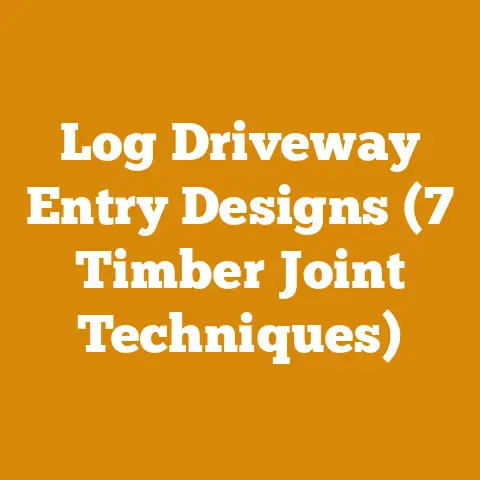Conveyor Belt DIY for Wood Processing (Pro Tips & Build Hacks)
Ever felt the sting of a project gone sideways because you missed a crucial detail? Building a conveyor belt for wood processing is no different. In fact, it’s a project where precision and understanding technical specs can save you a whole lot of heartache (and maybe even a few fingers!). I’ve spent years wrestling with logs, splitting firewood, and trying to make my wood processing setup more efficient. That’s why I’m diving deep into the world of DIY conveyor belts, sharing everything I’ve learned – the good, the bad, and the downright ugly. This isn’t just a guide; it’s a collection of hard-earned wisdom, packed with pro tips and build hacks to help you conquer this ambitious project. Let’s get started, shall we?
The Allure of Automation: Why Build a DIY Conveyor Belt?
Okay, let’s be honest. Moving wood is back-breaking work. Whether you’re a hobbyist processing firewood for your own home, or a small-scale logger, the repetitive lifting and hauling can take a serious toll. That’s where the idea of a conveyor belt comes in. It’s about transforming drudgery into efficiency. It’s about saying goodbye to constant heavy lifting and hello to a smoother, safer workflow.
I remember the first time I saw a commercial wood processing setup with a conveyor belt. I was mesmerized! Logs flowed effortlessly, almost magically, from the splitter to the stacking area. It looked like something out of a dream. I immediately thought, “I need that!” But the price tag on those commercial systems? Let’s just say it was enough to make my wallet weep.
That’s what led me down the path of DIY. I figured, with a little ingenuity and elbow grease, I could build my own. And while it wasn’t always easy, the results have been well worth the effort. I’ve significantly reduced the physical strain, boosted my processing speed, and, frankly, made the whole process more enjoyable.
Benefits of a DIY Conveyor Belt for Wood Processing
- Reduced Physical Strain: The biggest win, hands down. No more aching backs or strained muscles.
- Increased Efficiency: Move more wood in less time.
- Improved Safety: Less manual handling means fewer opportunities for accidents.
- Customization: Build a conveyor belt tailored to your specific needs and workspace.
- Cost Savings: Significantly cheaper than buying a commercial system.
- Satisfaction: There’s a unique sense of accomplishment that comes with building something yourself.
Potential Drawbacks
- Time Commitment: Building a conveyor belt takes time and effort.
- Technical Skills Required: You’ll need some basic fabrication and mechanical skills.
- Material Costs: While cheaper than a commercial system, materials can still add up.
- Safety Concerns: Proper design and construction are crucial to prevent accidents.
- Maintenance: Like any mechanical system, a conveyor belt will require regular maintenance.
Understanding the User Intent: What Are You Trying to Achieve?
Before you even think about picking up a wrench, take a step back and define your goals. What exactly do you want your conveyor belt to do? This is crucial because it will dictate the design, materials, and overall complexity of your project.
Here are some questions to consider:
- What type of wood will you be processing? Softwoods (pine, fir) are lighter and easier to handle than hardwoods (oak, maple). This will affect the required belt strength and motor power.
- What size logs will you be handling? Larger logs require a wider, sturdier belt.
- What volume of wood will you be processing? A high-volume operation will require a more robust and reliable system.
- What is the desired throughput (logs per hour)? This will determine the belt speed and motor power.
- What is the available space? This will influence the conveyor belt’s length, width, and configuration.
- What is your budget? This will impact your choice of materials and components.
- What are your skill levels in fabrication, welding, and electrical wiring? Be realistic about your abilities and don’t be afraid to seek help from experts.
Example Scenarios:
- Scenario 1: Hobbyist Firewood Processor: Processing a few cords of firewood per year from small- to medium-sized logs. The focus is on affordability and ease of use.
- Scenario 2: Small-Scale Logger: Processing larger logs on a more regular basis. The focus is on durability, reliability, and increased throughput.
- Scenario 3: Custom Woodworker: Moving lumber and wood pieces within a workshop setting. The focus is on precision, controlled speed, and minimizing damage to the wood.
Core Components: The Anatomy of a Conveyor Belt
A conveyor belt system, at its heart, is relatively simple. But understanding each component and its function is crucial for a successful DIY build.
- Belt: The heart of the system. It carries the wood from one point to another.
- Frame: Provides structural support for the entire system.
- Drive System: Consists of a motor, gearbox, and drive pulley, which powers the belt.
- Idler Pulleys: Support the belt and maintain tension.
- Bearings: Allow the pulleys to rotate smoothly.
- Take-Up System: Used to adjust belt tension.
- Support Rollers (Optional): Provide additional support for the belt, especially for heavy loads.
- Side Guides (Optional): Prevent wood from falling off the belt.
- Electrical Controls: Used to control the motor and other electrical components.
- Safety Features: Emergency stops, guards, and other safety devices.
Deep Dive into Key Components
1. The Belt: Material Matters
The choice of belt material is critical. It needs to be strong, durable, and resistant to wear and tear. I’ve experimented with several materials, and here’s what I’ve learned:
- Rubber Belts: A common choice for general-purpose applications. They offer good grip and abrasion resistance. Look for belts with multiple plies (layers of fabric reinforcement) for increased strength.
- PVC Belts: Lighter and more flexible than rubber belts. They are suitable for lighter loads and dry environments.
- Cleated Belts: Feature raised cleats that provide excellent grip, especially when conveying wood up inclines. Ideal for firewood processing.
- Metal Belts: Used in heavy-duty applications where high temperatures or abrasive materials are involved. Not typically necessary for wood processing.
Technical Considerations:
- Belt Width: Determined by the size of the logs you’ll be handling. A wider belt provides more stability. I recommend at least 12 inches for firewood and 18-24 inches for larger logs.
- Belt Thickness: Thicker belts are stronger and more durable but also more expensive. Choose a thickness appropriate for the load.
- Ply Rating: Indicates the number of layers of fabric reinforcement in the belt. Higher ply ratings mean greater strength.
- Tensile Strength: Measures the belt’s resistance to stretching and breaking. Choose a belt with a tensile strength that exceeds the maximum load you expect to carry.
- Cleat Height and Spacing (for cleated belts): Affect the belt’s ability to grip and convey wood up inclines. Experiment to find the optimal configuration for your needs.
Data Point: A 3-ply rubber belt with a tensile strength of 200 PSI is generally suitable for handling firewood logs up to 12 inches in diameter. For larger logs, consider a 4-ply or 5-ply belt with a higher tensile strength.
2. The Frame: Strength and Stability
The frame is the backbone of the conveyor belt. It needs to be strong enough to support the weight of the belt, the wood, and the drive system.
- Steel: The most common material for conveyor belt frames. It’s strong, durable, and relatively easy to work with. I recommend using steel tubing or angle iron for the frame.
- Aluminum: Lighter than steel but also more expensive. Suitable for smaller, portable conveyor belts.
- Wood: Can be used for lightweight applications, but it’s not as durable or resistant to moisture as steel or aluminum.
Technical Considerations:
- Material Thickness: Choose a material thickness that is appropriate for the load. For steel frames, I recommend using at least 1/8-inch thick tubing or angle iron.
- Welding: Proper welding techniques are essential for creating a strong and durable frame. If you’re not comfortable welding, consider hiring a professional.
- Bracing: Use cross-bracing to add rigidity to the frame and prevent it from twisting or bending.
- Support Legs: Provide stable support for the conveyor belt. Make sure the legs are adjustable so you can level the belt on uneven ground.
Case Study: In one of my early projects, I underestimated the strength required for the frame. I used thinner steel tubing than I should have, and the frame started to bend under heavy loads. I had to reinforce the frame with additional bracing, which added extra time and expense to the project. Lesson learned: overbuild rather than underbuild!
3. The Drive System: Power and Control
The drive system is what makes the belt move. It consists of a motor, gearbox, and drive pulley.
- Motor: Provides the power to drive the belt. Choose a motor with sufficient horsepower to handle the load.
- Gearbox: Reduces the motor speed and increases the torque. This is necessary to provide the required belt speed and pulling power.
- Drive Pulley: Transfers the power from the gearbox to the belt.
Technical Considerations:
- Motor Horsepower: Determined by the belt speed, load, and conveyor belt length. A general rule of thumb is to use 1 horsepower for every 10 feet of conveyor belt length, assuming a moderate load.
- Gearbox Ratio: Affects the belt speed and torque. A higher gearbox ratio results in a slower belt speed and higher torque.
- Pulley Diameter: Affects the belt speed. A larger pulley diameter results in a faster belt speed.
- Motor Voltage and Phase: Choose a motor that is compatible with your electrical system.
- Variable Frequency Drive (VFD): Allows you to adjust the motor speed, providing greater control over the conveyor belt.
Data Point: For a 20-foot conveyor belt handling firewood logs, a 2-horsepower motor with a 20:1 gearbox ratio and a 6-inch drive pulley would be a good starting point.
4. Idler Pulleys: Smooth Operation
Idler pulleys support the belt and maintain tension. They need to be durable and rotate smoothly to minimize friction and wear.
- Steel Pulleys: The most common choice for conveyor belt systems. They are strong, durable, and relatively inexpensive.
- Plastic Pulleys: Lighter than steel pulleys and resistant to corrosion. Suitable for lighter loads and wet environments.
Technical Considerations:
- Pulley Diameter: Affects the belt tension and the amount of stress on the belt. Larger diameter pulleys reduce belt stress.
- Bearing Type: Choose bearings that are designed for radial loads and high speeds.
- Pulley Spacing: Affects the belt sag. Closer pulley spacing reduces belt sag.
5. Take-Up System: Maintaining Tension
The take-up system is used to adjust the belt tension. Over time, belts can stretch, and the take-up system allows you to compensate for this stretching.
- Screw Take-Up: The most common type of take-up system. It uses a screw to adjust the position of the idler pulley.
- Gravity Take-Up: Uses a weighted pulley to maintain belt tension.
Technical Considerations:
- Take-Up Travel: The amount of adjustment provided by the take-up system. Choose a take-up system with sufficient travel to accommodate belt stretching.
- Take-Up Location: The take-up system should be located on the slack side of the belt (the side opposite the drive pulley).
6. Optional Components: Enhancing Functionality
- Support Rollers: Provide additional support for the belt, especially for heavy loads. They are placed underneath the belt to prevent sagging.
- Side Guides: Prevent wood from falling off the belt. They can be made from steel, wood, or plastic.
- Electrical Controls: Used to control the motor and other electrical components. This can include a simple on/off switch, a variable frequency drive (VFD), and safety interlocks.
- Safety Features: Emergency stops, belt guards, and other safety devices are essential for preventing accidents.
Design Considerations: Putting It All Together
Now that you understand the core components, let’s talk about designing your conveyor belt system.
1. Determining Belt Length and Angle
The length and angle of your conveyor belt will depend on your specific needs and workspace.
- Belt Length: Measure the distance between the infeed and outfeed points. Add some extra length for the take-up system and for wrapping around the pulleys.
- Belt Angle: Consider the angle of incline. Steeper angles require cleated belts and more powerful motors. I’ve found that an angle of no more than 20 degrees is generally manageable for firewood processing.
2. Calculating Load Capacity
It’s crucial to calculate the load capacity of your conveyor belt to ensure it can handle the weight of the wood you’ll be processing.
- Wood Density: Different types of wood have different densities. Hardwoods are denser than softwoods.
- Log Size and Weight: Estimate the average size and weight of the logs you’ll be handling.
- Belt Speed: Faster belt speeds result in higher throughput but also increase the load on the belt.
Formula:
Load Capacity (lbs/ft) = (Wood Density (lbs/ft³) x Log Volume (ft³)) / Belt Width (ft)
Example:
Let’s say you’re processing oak firewood logs that are 12 inches in diameter and 16 inches long. The density of oak is approximately 45 lbs/ft³. Your conveyor belt is 18 inches wide (1.5 feet).
- Calculate Log Volume:
- Radius = 6 inches = 0.5 feet
- Length = 16 inches = 1.33 feet
- Volume = πr²h = 3.14 x (0.5 ft)² x 1.33 ft = 1.05 ft³
- Calculate Log Weight:
- Weight = Density x Volume = 45 lbs/ft³ x 1.05 ft³ = 47.25 lbs
- Calculate Load Capacity:
- Load Capacity = (45 lbs/ft³ x 1.05 ft³) / 1.5 ft = 31.5 lbs/ft
This means that your conveyor belt needs to be able to handle a load of at least 31.5 lbs per foot.
3. Selecting Motor and Gearbox
The motor and gearbox need to be sized appropriately for the load and belt speed.
- Horsepower: As mentioned earlier, a general rule of thumb is to use 1 horsepower for every 10 feet of conveyor belt length, assuming a moderate load. Increase the horsepower if you’re handling heavier loads or using a steeper incline.
- Gearbox Ratio: Choose a gearbox ratio that will provide the desired belt speed. A higher gearbox ratio results in a slower belt speed and higher torque.
Formula:
Belt Speed (ft/min) = (Motor RPM x Pulley Circumference (ft)) / Gearbox Ratio
Example:
Let’s say you want a belt speed of 50 ft/min. Your motor has a speed of 1750 RPM. Your drive pulley has a diameter of 6 inches (0.5 feet).
- Calculate Pulley Circumference:
- Circumference = πd = 3.14 x 0.5 ft = 1.57 ft
- Calculate Gearbox Ratio:
- Gearbox Ratio = (Motor RPM x Pulley Circumference) / Belt Speed
- Gearbox Ratio = (1750 RPM x 1.57 ft) / 50 ft/min = 55:1
This means that you would need a gearbox with a ratio of approximately 55:1 to achieve a belt speed of 50 ft/min.
4. Choosing Belt Material and Width
Select a belt material and width that is appropriate for the type of wood you’ll be processing and the load capacity.
- Belt Material: Rubber belts are a good general-purpose choice. Cleated belts are ideal for inclines.
- Belt Width: Choose a width that is wide enough to accommodate the largest logs you’ll be handling.
5. Designing the Frame
The frame needs to be strong and stable enough to support the weight of the belt, the wood, and the drive system.
- Material: Steel tubing or angle iron are good choices for the frame.
- Bracing: Use cross-bracing to add rigidity to the frame.
- Support Legs: Provide stable support for the conveyor belt.
6. Incorporating Safety Features
Safety is paramount when building and operating a conveyor belt.
- Emergency Stops: Install emergency stop buttons at convenient locations along the conveyor belt.
- Belt Guards: Cover all moving parts, such as pulleys and belts, to prevent accidental contact.
- Interlocks: Use interlocks to prevent the conveyor belt from starting if the guards are not in place.
- Warning Labels: Place warning labels on the conveyor belt to remind users of potential hazards.
Step-by-Step Build Guide: From Blueprint to Reality
Okay, so we’ve covered the theory. Now let’s get our hands dirty! This is a general guide, and you’ll need to adapt it to your specific design and materials.
Tools and Materials:
- Steel tubing or angle iron for the frame
- Conveyor belt
- Motor and gearbox
- Drive pulley and idler pulleys
- Bearings
- Take-up system
- Welding equipment (or access to a welder)
- Cutting tools (saw, grinder)
- Drill
- Fasteners (bolts, nuts, screws)
- Electrical wiring and components
- Safety equipment (welding helmet, gloves, safety glasses)
Step 1: Build the Frame
- Cut the steel tubing or angle iron to the desired lengths. Use a saw or grinder to make precise cuts.
- Weld the frame together. Ensure that the frame is square and level. Use cross-bracing to add rigidity.
- Attach the support legs. Make sure the legs are adjustable so you can level the belt on uneven ground.
Step 2: Install the Pulleys and Bearings
- Mount the bearings to the frame. Use bolts or screws to secure the bearings in place.
- Install the drive pulley and idler pulleys. Ensure that the pulleys are aligned properly.
Step 3: Install the Drive System
- Mount the motor and gearbox to the frame. Use bolts or screws to secure the motor and gearbox in place.
- Connect the motor and gearbox to the drive pulley. Use a belt or chain to transfer the power from the gearbox to the drive pulley.
- Wire the motor. Follow all electrical codes and safety regulations.
Step 4: Install the Belt
- Thread the belt around the pulleys. Make sure the belt is properly aligned.
- Connect the ends of the belt. Use a belt fastener or vulcanizing process to join the ends of the belt.
- Adjust the belt tension. Use the take-up system to adjust the belt tension. The belt should be tight enough to prevent slippage but not so tight that it puts excessive stress on the pulleys and bearings.
Step 5: Add Optional Components
- Install support rollers. Place the support rollers underneath the belt to prevent sagging.
- Install side guides. Attach the side guides to the frame to prevent wood from falling off the belt.
- Install electrical controls. Wire the motor to the electrical controls.
- Install safety features. Install emergency stop buttons, belt guards, and other safety devices.
Step 6: Test and Adjust
- Test the conveyor belt. Run the conveyor belt at a slow speed and check for any problems.
- Adjust the belt tension, alignment, and speed as needed. Make sure the belt is running smoothly and efficiently.
- Load test the conveyor belt. Gradually increase the load on the conveyor belt to ensure it can handle the weight of the wood you’ll be processing.
Personalized Storytelling: My DIY Conveyor Belt Journey
I’ll never forget the day I finally fired up my first DIY conveyor belt. It was a Frankensteinian creation, cobbled together from salvaged steel, a repurposed washing machine motor, and a rubber belt I’d snagged from a defunct printing press. It looked… well, let’s just say it wasn’t pretty. But when I flipped the switch and that belt started moving, carrying a log effortlessly up to my splitter, I felt like I’d conquered the world.
Of course, it wasn’t all smooth sailing. There were plenty of hiccups along the way. The belt kept slipping, the frame vibrated like a jackhammer, and the motor overheated after just a few minutes of use. But with each problem, I learned something new.
That first conveyor belt was a learning experience, and it paved the way for more refined and efficient designs. I’ve since built several conveyor belts, each one an improvement over the last. I’ve learned to appreciate the importance of precision, the value of quality materials, and the satisfaction of building something that makes my work easier and more enjoyable.
Safety First: A Non-Negotiable Priority
I can’t stress this enough: safety must be your top priority when building and operating a conveyor belt. These machines can be dangerous if not designed and used properly. I’ve seen firsthand the damage they can inflict, and I wouldn’t wish that on anyone.
- Always wear safety glasses and gloves when working on the conveyor belt.
- Never wear loose clothing or jewelry that could get caught in the moving parts.
- Keep your hands and fingers away from the belt and pulleys while the conveyor belt is running.
- Use emergency stop buttons to shut down the conveyor belt in case of an emergency.
- Never operate the conveyor belt without the belt guards in place.
- Inspect the conveyor belt regularly for any signs of wear or damage.
- Repair any damage immediately.
- Follow all electrical codes and safety regulations when wiring the motor.
- Never operate the conveyor belt in wet or damp conditions.
- Train all users on the proper operation and safety procedures for the conveyor belt.
Data Point: According to the National Safety Council, conveyor belt accidents account for a significant number of workplace injuries each year. Proper safety procedures and equipment can significantly reduce the risk of accidents.
Troubleshooting: When Things Go Wrong
Even with the best design and construction, things can still go wrong. Here are some common problems and how to fix them:
- Belt Slippage: Caused by insufficient belt tension, a worn belt, or a dirty pulley. Tighten the belt, replace the belt if necessary, and clean the pulleys.
- Belt Misalignment: Caused by misaligned pulleys or a damaged belt. Align the pulleys and replace the belt if necessary.
- Motor Overheating: Caused by overloading the motor or insufficient ventilation. Reduce the load, improve ventilation, or replace the motor with a more powerful one.
- Frame Vibration: Caused by unbalanced pulleys or a weak frame. Balance the pulleys and reinforce the frame.
- Bearing Failure: Caused by overloading the bearings or insufficient lubrication. Replace the bearings and lubricate them regularly.
- Electrical Problems: Caused by faulty wiring or a blown fuse. Inspect the wiring and replace any faulty components.
The Future of DIY Wood Processing
As technology advances, I see even more exciting possibilities for DIY wood processing. Imagine integrating sensors to automatically adjust belt speed based on log size, or using computer vision to identify and sort different types of wood. The possibilities are endless!
But even with all the technological advancements, the core principles of DIY will remain the same: ingenuity, resourcefulness, and a willingness to learn. Building your own conveyor belt is not just about saving money; it’s about empowering yourself and taking control of your wood processing operation.
Final Thoughts: Embrace the Challenge
Building a DIY conveyor belt for wood processing is a challenging but rewarding project. It requires careful planning, attention to detail, and a willingness to learn. But with the right knowledge, skills, and tools, you can build a system that will significantly improve your efficiency, reduce your physical strain, and make your wood processing operation more enjoyable.
So, take a deep breath, gather your materials, and embrace the challenge. You might be surprised at what you can accomplish. And who knows, maybe one day you’ll be sharing your own DIY conveyor belt success story!






